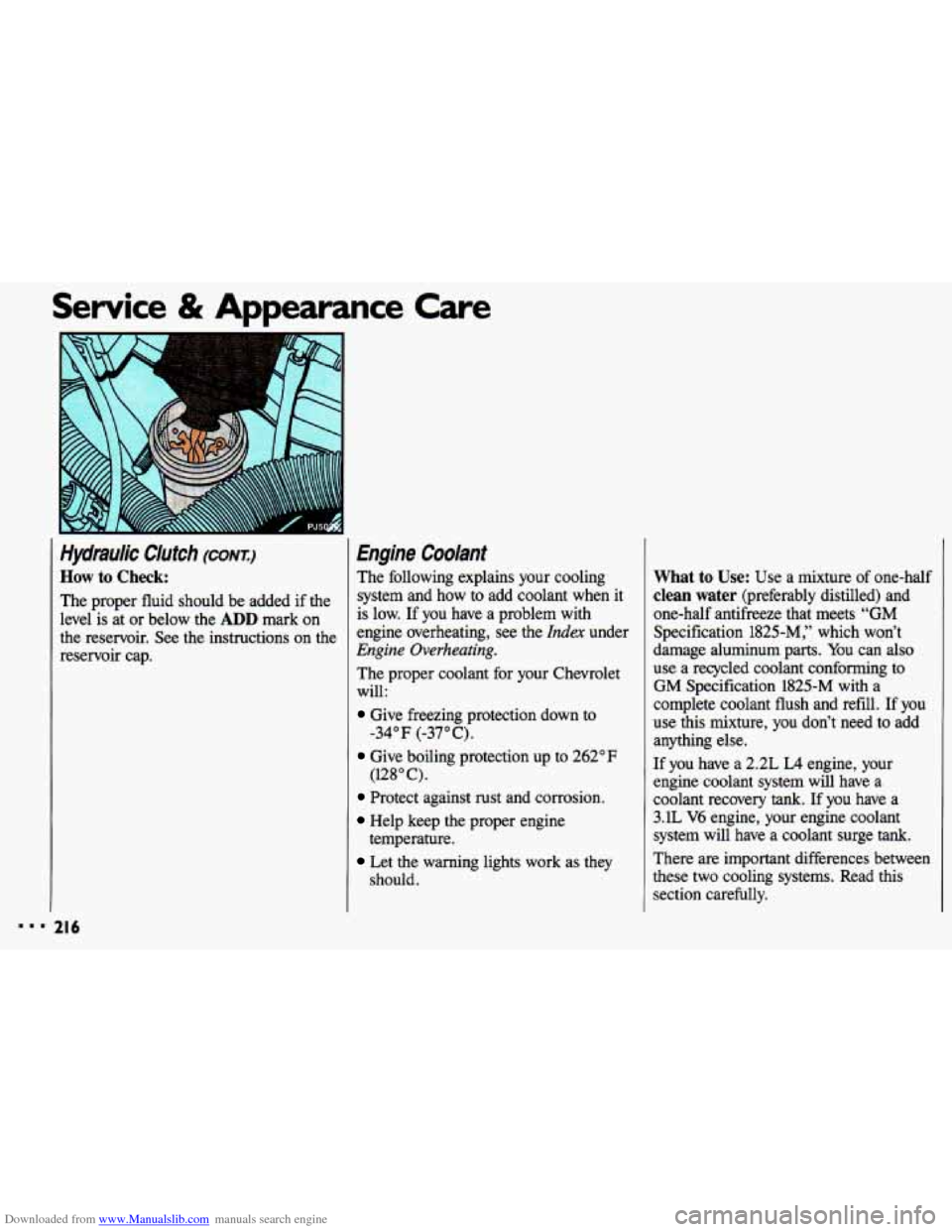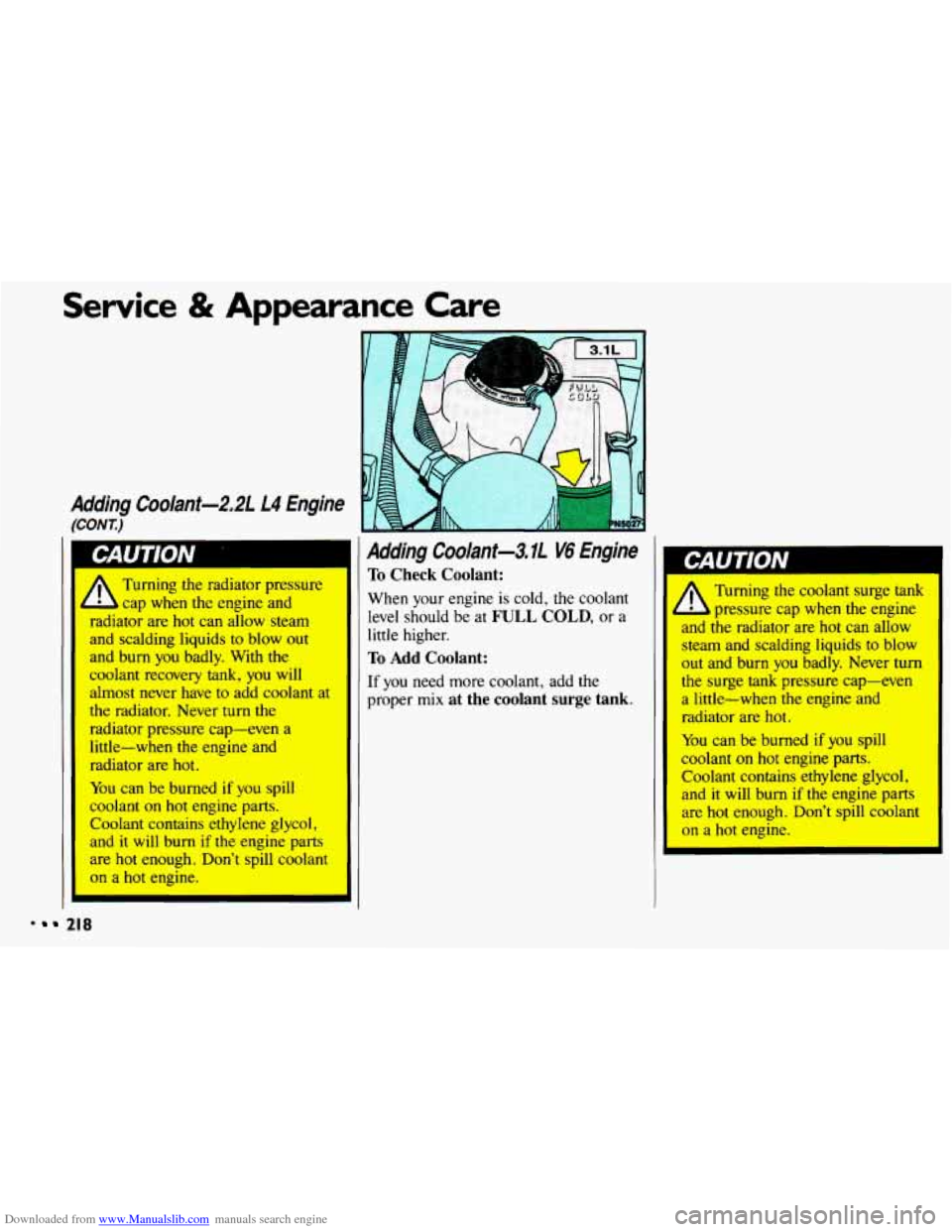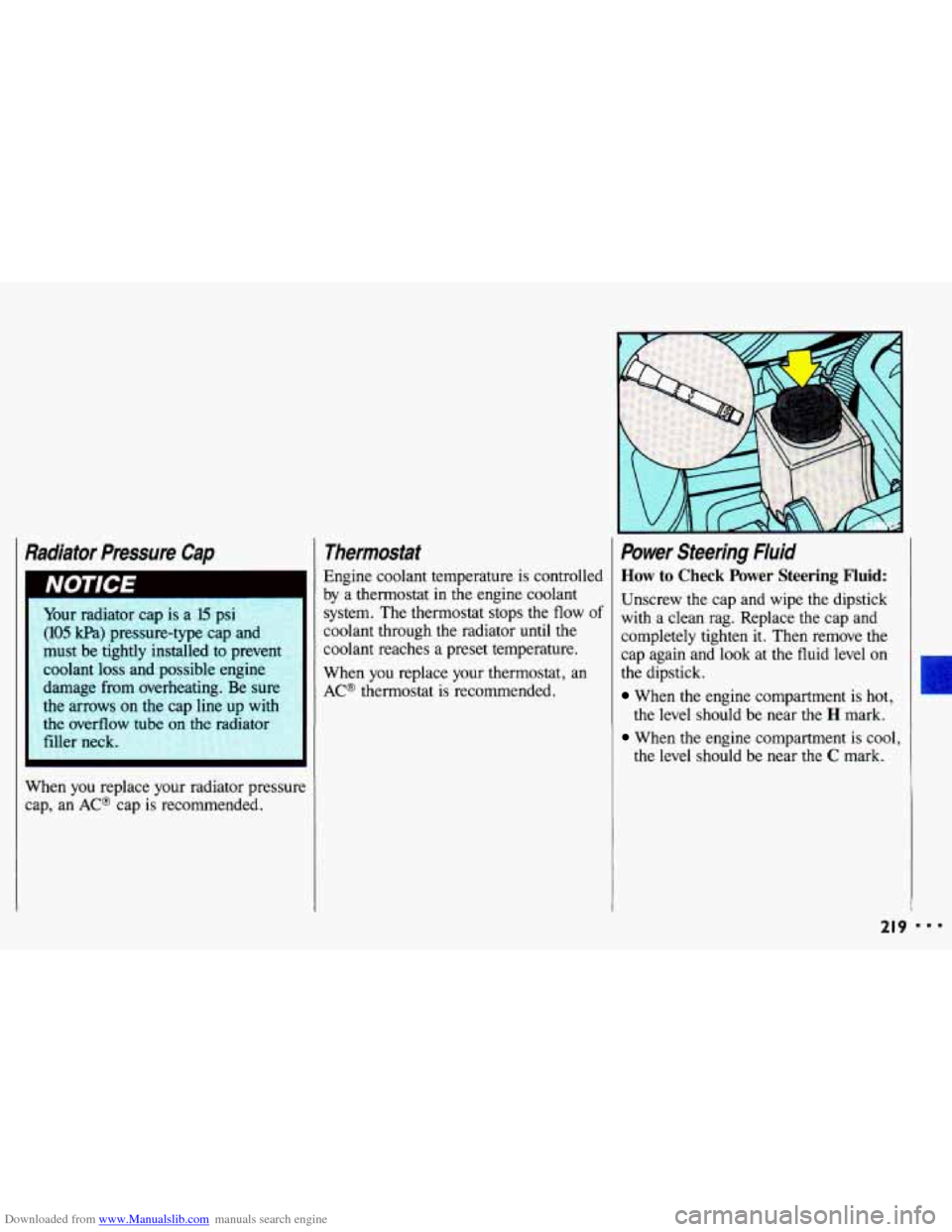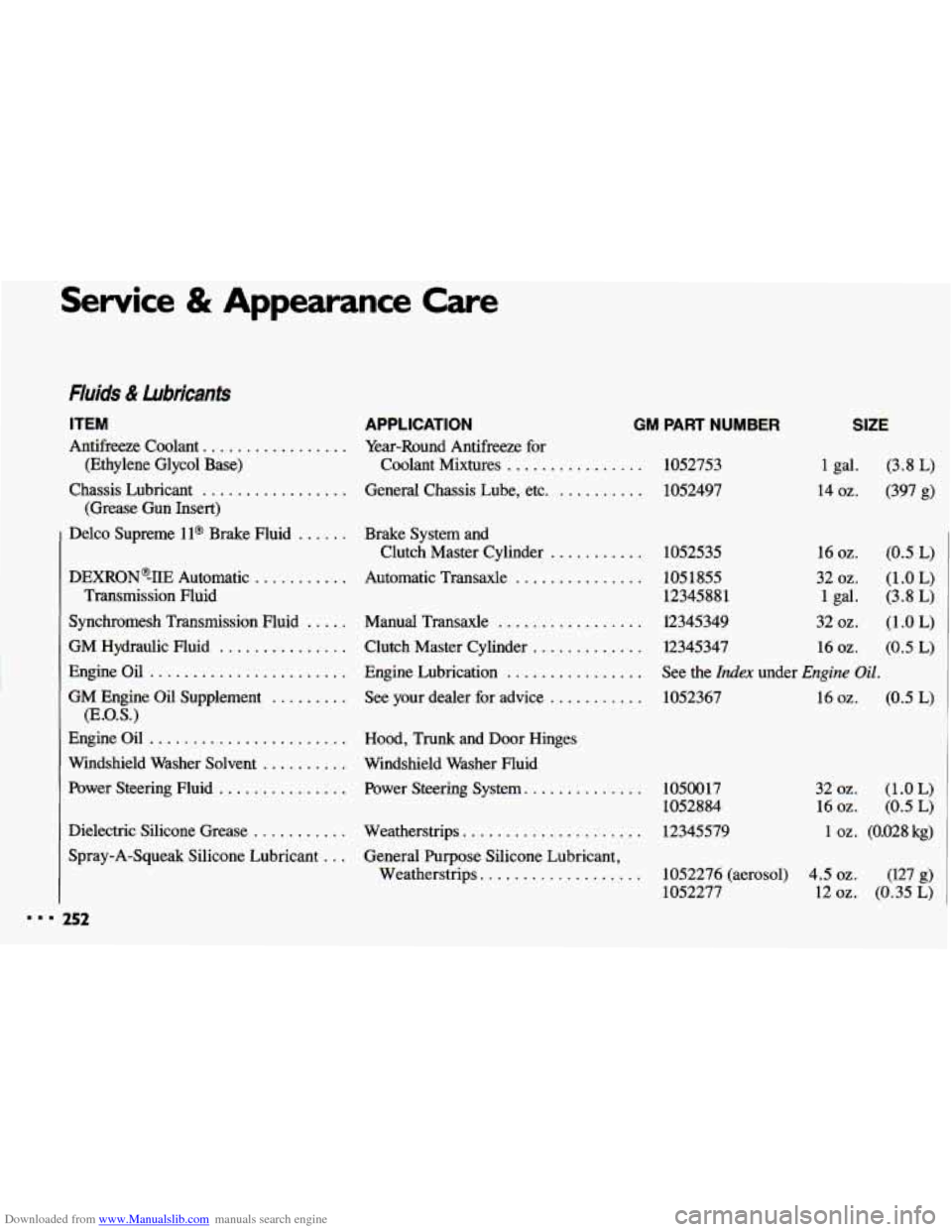Page 204 of 308
Downloaded from www.Manualslib.com manuals search engine Service & Appearance Care
Hood Release (CONI)
Lift the hood, release the hood prop
from its retainer and put the hood prop
into the slot in the hood.
1 I
I An electric fan under the hood
can start up and injure you
even when the engine is not
running. Keep hands, clothing and
tools away from
any underhood
electric fan.
b
B
fi
h
P
S:
it
a Things that burn can get on
L hot engine parts and start a
me. These include liquids like
gasoline,
oil, coolant, brake fluid,
windshield washer and other
fluids, and plastic or rubber.
You
or others could be burned. Be
careful not to drop or spill things
that will burn onto a hot engine.
lefore closing the hood, be sure all the
iller caps are on properly. Then
lift the
ood to relieve pressure
on the hood
rop. Remove the hood prop from the
lot in the hood and return the prop to
:s retainer. Then just let the hood down
nd close
it firmly.
. 202
Page 205 of 308
Downloaded from www.Manualslib.com manuals search engine d
56053
2.21 L4 Engine (CODE 4)
When you open the hood, you’ll see:
1. Engine Coolant Recovery Tank
2. Power Steering Fluid Reservoir
3. Automatic Transaxle Fluid Dipstick
4. Brake Fluid Reservoir
5. Hydraulic Clutch Fluid Reservoir
6. Windshield Washer Fluid Reservoir
7. Battery
8. Air Cleaner
9. Engine Oil Dipstick
IO. Engine Oil Fill Cap
1 1. Radiator Pressure Cap
(if equipped)
(if equipped)
203
Page 206 of 308
Downloaded from www.Manualslib.com manuals search engine Service & Appearance Care
' 3.11 V6 Engine (CODE T)
1
When you open the hood, you'll see:
1. Coolant Surge Tank
2. Power Steering Fluid Reservoir
3. Automatic Transaxle Fluid Dipstick
4. Brake Fluid Reservoir
5. Hydraulic Clutch Fluid Reservoir
6. Windshield Washer Fluid Reservoir
7. Battery
8. Air Cleaner
9. Engine Oil Fill Cap
10. Engine Oil Dipstick
(if equipped)
(if equipped)
rn 204
Page 218 of 308

Downloaded from www.Manualslib.com manuals search engine 888
Service rance Care
Hydraulic Clutch (CONTJ
How to Check:
The proper fluid should be added if the
level is at or below the
ADD mark on
the reservoir.
See the instructions on the
reservoir cap.
216
Engine Coolant
The following explains your cooling
system and how to add coolant when it
is low. If you have a problem with
engine overheating,
see the Index under
Engine Overheating.
The proper coolant for your Chevrolet
will:
Give freezing protection down to
Give boiling protection up to 262°F
Protect against rust and corrosion.
Help keep the proper engine
Let the warning lights work as they
-34" F (-37" C).
(128" C).
temperature.
should.
What to Use: Use a mixture of one-half
clean water (preferably distilled) and
one-half antifreeze that meets "GM
Specification 1825-M," which won't
damage aluminum parts.
You can also
use a recycled coolant conforming to
GM Specification 1825-M with a
complete coolant flush and refill.
If you
use this mixture, you don't need to add
anything else.
If you have a 2.2L LA engine, your
engine coolant system will have a
coolant recovery
tank. If you have a
3.1L V6 engine, your engine coolant
system will have a coolant surge
tank.
There are important differences between
these two cooling systems. Read this section carefully.
Page 219 of 308
Downloaded from www.Manualslib.com manuals search engine L Adding only plain water to - your cooling system can be
dangerous. Plain water,
or some
other liquid like alcohol, can boil
before the proper coolant
mix will.
Your vehicle's coolant warning
system
is set for the proper coolant
mix. With plain water or the
wrong mix, your engine could get
too hot but
you wouldn't get the
overheat warning. Your engine
could catch
fire and you or others
could be burned. Use a
50150 mix
of clean water and a proper
antifreeze.
Adding Coolant-2,21 L4 Engine
To Check Coolant:
When your engine
is cold, the coolant
level should be at
FULL COLD, or a
little higher. When your engine
is warm,
the level should be up to
mJLL HOT,
or a little higher.
To Add Coolant:
If you need more coolant, add the
proper
mix at the coolant recovery
tank.
Page 220 of 308

Downloaded from www.Manualslib.com manuals search engine Service & Appearance Care
I
Adding Co01ant-2~2L L4 Engine
(CONT.)
A
Turning the radiator pressure
cap
when the engine and
radiator are hot can allow steam
and scalding liquids
to blow out
and
burn you badly. With the
coolant
recovery tank, you will
almost never have to add coolant at
the radiator. Never turn the
radiator
pressure cap-even a
little-when the engine and radiator are hot.
II
1 I Adding C00lant-3~IL V6 Engine
You can be burned if you spill
coolant on hot engine parts. Coolant
contains ethylene glycol,
and it will burh if the engine parts
are hot enough. Don’t spill coolant
II
on a hot eniine.
I 31
II
To Check Coolant:
When your engine is cold, the coolant
level should be at
FULL COLD, or a
little higher.
To Add Coolant:
If you need more coolant, add the
proper
mix at the coolant surge tank
1 I
Turning the coolant surge tank
d L pressure cap when the engine
and the radiator are hot c~ln allow
steam and scalding liquids to blow
out and
bum you badly. Never turn
the surge tank pressure cap-even
a little-when the engine and
radiator are hot.
You can be burned if you spill
coolant on
hot engine parts.
Coolant contains ethylene glycol, and
it will bum if the engine parts
are hot enough. Don’t spill coalant
on a hot engine.
- 218
Page 221 of 308

Downloaded from www.Manualslib.com manuals search engine Radiator Pressure Cap
, .. g.., ',!: Your radiator cap is a 15 psi
I.,, ''.' (105 kPa) pressure-type cap and
,;:, must be tightly installed to prevent
'.. coolant loss and possible engine
.':: damage from overheating. Be sure
.; the arrows on the cap line up with
the overflow
tube on the radiator
Y; _/,.__ filler neck.
When you replace your radiator pressurl
cap, an
AC@ cap is recommended.
.. . ..
~. .
..
F+
Thermostat
Engine coolant temperature is controlled
by a thermostat in the engine coolant
system. The thermostat stops the
flow of
coolant through the radiator until the
coolant reaches a preset temperature.
When you replace your thermostat, an
AC@ thermostat is recommended.
Power Steering Fluid
How to Check Power Steering Fluid:
Unscrew the cap and wipe the dipstick
with a clean rag. Replace the cap and
completely tighten it. Then remove the
cap again and
look at the fluid level on
the dipstick.
When the engine compartment is hot,
the level should be near the H mark.
When the engine compartment is cool,
the level should be near the
C mark.
21 9 I..
Page 254 of 308

Downloaded from www.Manualslib.com manuals search engine Service & Appearance Care
Fluids & Lubricants
ITEM APPLICATION
Antifreeze Coolant ................. Year-Round Antifreeze for
(Ethylene Glycol Base) Coolant Mixtures
................
Chassis Lubricant ................. General Chassis Lube, etc. ..........
(Grease Gun Insert)
GM PART NUMBER
Delco Supreme ll@ Brake Fluid ...... Brake System and
Clutch Master Cylinder
...........
DEXRON %E Automatic ........... Automatic Transaxle ...............
Transmission Fluid
Synchromesh Transmission Fluid
..... Manual Transaxle .................
GM Hydraulic Fluid ............... Clutch Master Cylinder .............
Engine Oil ....................... Engine Lubrication ................
GM Engine Oil Supplement ......... See your dealer for advice ...........
(E.O.S.)
Engine Oil ..................... Hood, Trunk and Door Hinges
Power Steering Fluid
............... Power Steering System. .............
Windshield Washer Solvent .......... Windshield Washer Fluid
Dielectric Silicone Grease
........... Weatherstrips .....................
Spray-A-Squeak Silicone Lubricant ... General Purpose Silicone Lubricant,
Weatherstrips.
..................
1052753
1052497
SIZE
1 gal.
14 02.
1052535 16 oz.
105 1855 32 02.
12345881 1 gal.
12345349 32 oz.
12345347 16 oz.
See the
Index under Engine Oil.
1052367 16 oz.
1050017
1052884
12345579 (3.8
L)
(397 g)
(0.5 L)
(1.0 L)
(3.8 L)
(1 .o L)
(0.5 L)
(0.5 L)
32 02. (1 .O L)
16 oz. (0.5 L)
1 oz. (0.028 kg)
1052276 (aerosol) 4.5 oz. (127 g)
1052277
12 oz. (0.35 L)
252